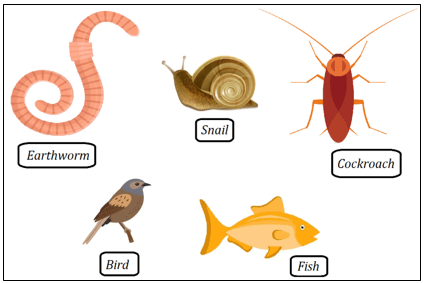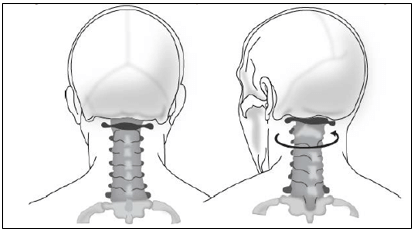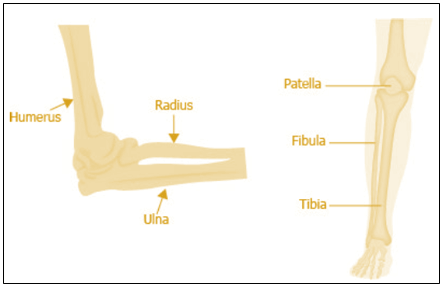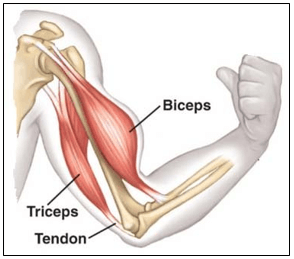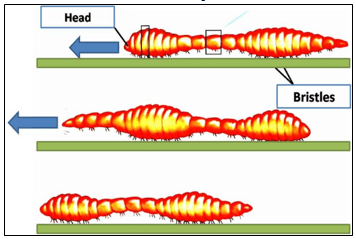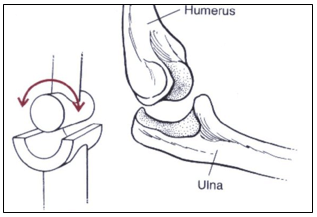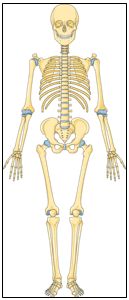Body Movements Worksheet
Objective Type Questions
- Match the items in Column A with the items in Column B.
- Fill in the blanks by choosing the appropriate word from those given in the brackets.
(fixed, hinge, pivot, ball and socket)
(a) In …………………. joint, the rounded end of one bone fits into the cavity of the other bone.
(b) A …………………. joint is where a cylindrical bone rotates in a ring.
(c) …………………. joints bring about movement in only back and forth direction.
(d) Joints at which bones cannot move are called …………………. joints. - Few organisms are shown below. Identify the organism based on the clues provided.
(a) My foot is a thick structure made of strong muscles which helps in dragging my body. I move in a wavy motion. Who am I?
(b) I do not have bones but can move forward by repeated muscle expansions and contractions. I have a large number of tiny bristles under my body. Who am I?
(c) I have hollow and light bones which help me fly in air. My shoulder bones are strong, and breastbones are modified. Who am I?
(d) I have a streamlined body and a skeleton covered with strong muscles. I also have fins. Who am I?
(e) I have three pairs of modified legs and two pairs of wings. I have distinct muscles which enable me to fly, walk and climb. Who am I? - Few structures associated with the human skeletal system are shown below. Identify these structures.
Multiple Choice Questions - Vivek observed a joint in the neck. He claimed that the joint is a pivotal joint. Is the claim made by Vivek, correct?
(a) No, as hinge joint is present in the head area.
(b) No, as pivotal joint is present in the jaw portion only.
(c) Yes, as it allows the individual to move its head in all directions.
(d) Yes, as it allows forward and backward bending and right or left turning of head. - The given picture shows the bones from the elbow and leg region. What is the similarity in the bones of these regions?
(a) The bones of both regions have the same length.
(b) The bones of both regions can move in all directions.
(c) The bones of both regions have the same type of joint.
(d) The bones of both regions are attached to the pelvic girdle. - The given image shows the human backbone which extends through most of the body. How does the backbone differ from the thigh bone, femur?
(a) Backbone is made of many small bones, while femur is a long bone.
(b) Backbone is a long bone, while femur is made of many small bones.
(c) Backbone is the smallest bone of the body, while femur is the longest bone.
(d) Backbone is the longest bone of the body, while femur is the smallest bone. - The image shows how the muscles help in the movement of the arm.
Based on the image, what will be the length of the muscles during bending?
(a) Both biceps and triceps relax
(b) Both biceps and triceps contract
(c) The biceps contract while the triceps relax
(d) The biceps relax while the triceps contracts - Meena observed the movement of an organism that lacks bones. Based on the manner of movement, which organism is it likely to be?
(a) Ant
(b) Cockroach
(c) Earthworm
(d) Snake - The table lists the characteristic features of body movements of various organisms.
Which organisms show these movements?
(a) A – Fish; B - Snail
(b) A – Snail; B - Snake
(c) A – Bird; B - Cockroach
(d) A – Snake; B – Earthworm - The given image shows the movement of a snake and a snail. What could be the likely reason for the movement in snakes to be sidewinding and that in snails to be in a wavy motion?
(a) In snakes, bones are present that are absent in snails.
(b) In snails, thin muscles are more compared to snakes.
(c) In snakes, thick muscles are present that are absent in snails.
(d) In snails, the number of bones is more as compared to snakes. - Which of the following enables fishes to flow around easily in the water?
(a) Small-sized body
(b) Streamlined body
(c) Presence of thin skin
(d) Presence of scales on their body - Birds can fly but not humans. Which of the following correctly explains the reason for the same?
(a) They have long bones.
(b) They have extra forelimbs.
(c) They have strong hind bones.
(d) They have hollow and light bones.
Subjective Questions - The image shows a joint found at the elbow.
(a) Which type of joint is present between the humerus and the ulna?
(b) Give one more example of the above joint.
(c) Why can our elbows not move backwards? - Why must two muscles work together to move a bone?
- Both cockroaches and birds have wings to fly in the air. However, only cockroaches can climb on the walls. What is the likely reason for this?
- Why do underwater divers wear fin-like flippers on their feet?
Case-Based Questions - All the bones in our body also form a framework to give a shape to our body. This framework is called the skeleton.
a) How does the structure of the skeletal system support the body?
(a) It protects the outer skin of the body from any injury.
(b) It provides a framework that gives shape to the body.
(c) It provides the site for storing all the nutrients in the body.
(d) It allows free movement of all the bones during locomotion.
b) The human skeleton is composed of around ………… bones at birth, while the number gradually decreases to ………… bones.
(a) 305, 206
(b) 206, 305
(c) 306, 205
(d) 205, 306
c) Which of the following is not a part of the skeletal system?
(a) Skull
(b) Ribs
(c) Breastbone
(d) Heart - Sukriti fell off from her scooty while she was driving to her college. She got herself bruised at several places and felt a sharp pain in her leg. She went to the doctor to examine herself. On examination, the doctor diagnosed that Sukriti had a fracture. He prescribed some medicines and suggested her to follow a proper diet.
a) Which technique the doctor must have used to diagnose that Sukriti had a fracture?
(a) X-ray
(b) CT scan
(c) ELISA
(d) MRI
b) What is the use of the above technique?
c) What precaution should one take when one gets a fracture?
d) What kind of food should we take for proper growth and upkeep of bones?
Assertion-Reasoning Questions
Below questions consist of two statements – Assertion (A) and Reason (R). Answer these questions selecting the appropriate option given below: - Assertion (A): The human skeleton is made up of bones, joints, and cartilage.
Reason (R): Cartilage is hard and tough, but bones are softer than cartilage. - Assertion (A): The place where two or more bones are joined together in a skeleton is known as a joint.
Reason (R): Tendons connects muscles to bones.
Explore more Science Sample papers and Solutions
-
Sample Papers for CBSE Class 6 Science Term 1 #1
-
Sample Papers for CBSE Class 6 Science Term 2 #1
- Components Of Food Worksheet
- Sorting Materials Into Groups Worksheet
- Separation Of Substances Worksheet
- Getting To Know Plants Worksheet
- The Living Organisms – Characteristics and Habitats Worksheet
- Motion And Measurement Of Distances Worksheet
- Light, Shadows And Reflections Worksheet
- Electricity and Circuits Worksheet
- Fun With Magnets Worksheet
- Air Around Us Worksheet
- Competency Based Questions for CBSE Class 6 Science
- Sample Papers for CBSE Class 6 Science Term 1 #2
- Sample Papers for CBSE Class 6 Science Term 2 #2


